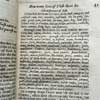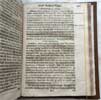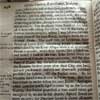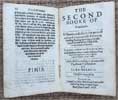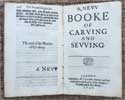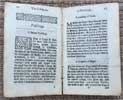Mollard.
John
- The rare first edition with very rare menu.
The Art of Cookery
MADE EASY AND REFINED; COMPRISING AMPLE DIRECTIONS FOR PREPARING EVERY ARTICLE REQUISITE FOR FURNISHING THE TABLES OF THE NOBLEMAN, GENTLEMAN, AND TRADESMAN. BY JOHN MOLLARD, Cook; One of the Proprietors of Freemasons’ Tavern, Great Queen Street, Lincoln’s Inn Fields. LONDON: PRINTED FOR THE AUTHOR, AND SOLD BY J, NUNN, GREAT QUEEN STREET, LINCOLN'S INN FIELDS. 1801. T. Beasley, Printer, Bolt Court, Fleet Street.
FIRST EDITION. Large octavo. 1fep. Half-Title. [1] Title page. [1] 1p Engraved Dedication leaf to the Original Proprietor of The London Tavern, very slightly browned. [1] (1)vi-viii Preface. (1)x-xxiv Contents. 12 Plates of Monthly Table Settings with each verso blank. (1)2-314. 21p Index. 1fep. The whole text block with wide margins. Modern dark brown full calf with with elaborate gilt tooled edges to the boards and the inner edges of the paste-downs. The spine with raised bands with elaborate gilt tooling and gilt devices in the compartments. With a black leather label and gilt letters. ALSO enclosed: A Freemason's Tavern Menu enclosed: Dated January 18th 1890. Mr E. Stanford’s Dinner. Consisting of six courses and seventeen dishes. Written in English. Printed on cream coloured card with gilt edges and fine decorative text. A very clean handsome copy of the very rare first edition, with the equally rare enclosed menu.
-
Before John Mollard owned the Freemason's Tavern he had been Head Cook at the London Tavern. In this book the beautifully scripted and engraved page is dedicated to the London Tavern Proprietor - Laurence Laforest, therein Mollard proclaims Laforest as a man of high reputation in the same Profession. In the Old Bailey records for May 14th 1777 at the trial of a George Hawkins who had stolen an engraved silver bowl and spoon from the London Tavern, we learn that Laforest was the owner of the Tavern with three other partners, Thomas Simkins, John Bladen and Henry Caridge. The unfortunate George Hawkins was found guilty, branded with a hot iron and received 8 lashes of the whip. In the same records we learn that two ladies were sentenced to be carried and whipped for 100 yards along Bishopsgate Street past the London Tavern. The contrast between the fine dining establishment of high standards and repute and the raw life-scenes outside are startling in the extreme. Lieut-Col. Newnham-Davis in his book 'Victorian London' 1899, writes extensively of the Freemasons' Tavern, and it is worth repeating parts here to give a glimpse of Mollard's past workplace and jointly owned establishment. -- The Tavern is not what the name implies. It was a restaurant, with a large public dining-room, with a fine ballroom, and with many private dining-rooms. Its outside was imposing (see picture 1 below). Two houses stand side by side. Built of red brick, with windows set in white stone and Elizabethan in appearance. At the entrance to the Tavern stand two great janitors. Facing the doorway, at the end of a wide hall, is a long flight of stairs broken by a broad landing and decorated with statues. Up and down this ladies and gentlemen are passing, and I ask one of the janitors what is going on in the ballroom. "German Liederkranz. Private entertainment. What dinner, sir? Victory Chapter. Drawing-room,” is the condensed information given by the big man, and he points a white-gloved hand to a passage branching off to the right.
On one side of the passage is a door leading into a bar where three ladies in black are kept very busy in attending to the wants of thirsty Freemasons. On the other side is a wide shallow alcove in the wall fitted with shelves and glazed over, and in this is a curious collection of plate, great salvers, candelabra, and centre-pieces. Beside the alcove is a glass door, and outside it is hung a placard with “Gavel Club. Private” upon it. At the end of the passage a little Staircase leads up to higher regions, and on the wall is an old-fashioned clock with a round face and very plain figures, and some oil paintings dark with age.
On the first landing there is a placard outside a door with “Victory Chapter” on it, and higher up outside another door another placard with “Perfection Chapter” on it. From the stream of guests and waiters which is setting up the stairs it is evident that there are many banquets to be held to-night.
The drawing-room is white-and-gold in colour. Four Corinthian pillars, the lower halves of which are painted old-gold colour, with gold outlining the curves of their capitals, support a highly-ornamented ceiling, the central panel of which is painted to represent clouds, with some little birds flitting before them. The paper is old-gold in colour with large flowers upon it. There is some handsome furniture in the room— a fine cabinet, a clock of elaborate workmanship, and some good china vases. The curtains to the windows are of red velvet. At the end of the room farthest from the door is a horseshoe table with red and white shaded candles on it, ferns, chrysanthemums, and heather in china pots, pines, and hothouse fruits, and at close intervals bottles of champagne and Apollinaris. At the other end of the room, where stands a piano, with a screen in front of it, the gentlemen in evening clothes are chatting, having put their coats and hats on chairs and piano wherever room can be found. The waiters, in black with white gloves, are putting the last touches to the decorations.
I have eaten some good dinners at the Freemasons’ Tavern, and others not so good. Tonight the cook is not up to his best form, and has not responded to the inspiration of the meuu ---
Crevettes - Tortue clair - Filets de sole Meunière - Vol-au-vent aux huîtres natives - Faisan Souvaroff - Selle de mouton - Céleri braise Bordelaise - Layer. Pommes Parisienne -
Poularde rôtie - Lard grillé - Salade - Bombe glacée Duchesse -
Os à la moëlle - Dessert - Café.
The turtle soup is not like that of the excellent Messrs. Ring and Brymer, or that of Mr. Painter; the faisan Souvaroff is dry, and the cook’s nerve has failed him when the truffles had to be added; but, on the other hand, the sole Meunière and the vol-au-vent are admirable, and the marrow-bones are large and scalding-hot.
After dinner, one by one the guests who have appointments elsewhere, or who are going to the theatre, say good-night and go off; but a remnant still remain, and these make an adjournment to a cosy little clubroom on the top story of Freemasons’ Hall, where good stories are told, and soda-water-bottle corks pop until long after midnight.
There is a small Masonic dining-club, called the Sphinx Club, which dines at the Freemasons’ Tavern, and which I mention because the dinner I last ate in company with my brother Sphinxes was one of the best efforts of the chef and of the manager Mons. Blanchette — which means that it was very good indeed. The club was founded as an antidote to the large amount of soft soap that Freemasons habitually plaster each other with in after-dinner speeches. No Sphinx is allowed to say anything good of any brother Sphinx, and when a candidate is put up for the club his proposer says all the ill he knows or can invent about his past life. A candidate can only become a member of the club by being unanimously blackballed. It is needless to say that the best of temper and good fellowship is the rule amongst the Sphinxes, and the Freemasons’ Tavern seems to always have a very good dinner for them. This was the menu of their last banquet ---
Huîtres - Tortue clair - Rouget à la Grenobloise - Caille à la Souvaroff - Agneau rôti - Sauce menthe - Choux de mer - Pommes noisettes - Bécasse sur canapé - Pommes paille - Salade de laitues - Os à la moëlle - Petit soufflé glacé rosette - Fondu au fromage - Dessert - Café. THE MENU enclosed with this book: Dated January 18th 1890. Mr E. Stanford’s Dinner at the Freemason's Tavern; Consisting of six courses and seventeen dishes. Written in English, the menu offers relatively plain sounding fare compared to the more elegant dinner of the above Sphinx Club, that is presented in French, by Lieut-Col. Newnham-Davis, nine years later, in his book of 'Victorian London' dated 1899. The bibliographies have their usual variance. Oxford & Vicaire have each a first of 1801 and Oxford a 3rd of 1807 and a new edition, 1836. Bitiing has a 2nd of 1802. Cagle also has a 2nd and a 4th of 1808.
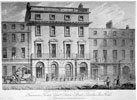





|
|

Antiquarian category
ref number:
11121
|









